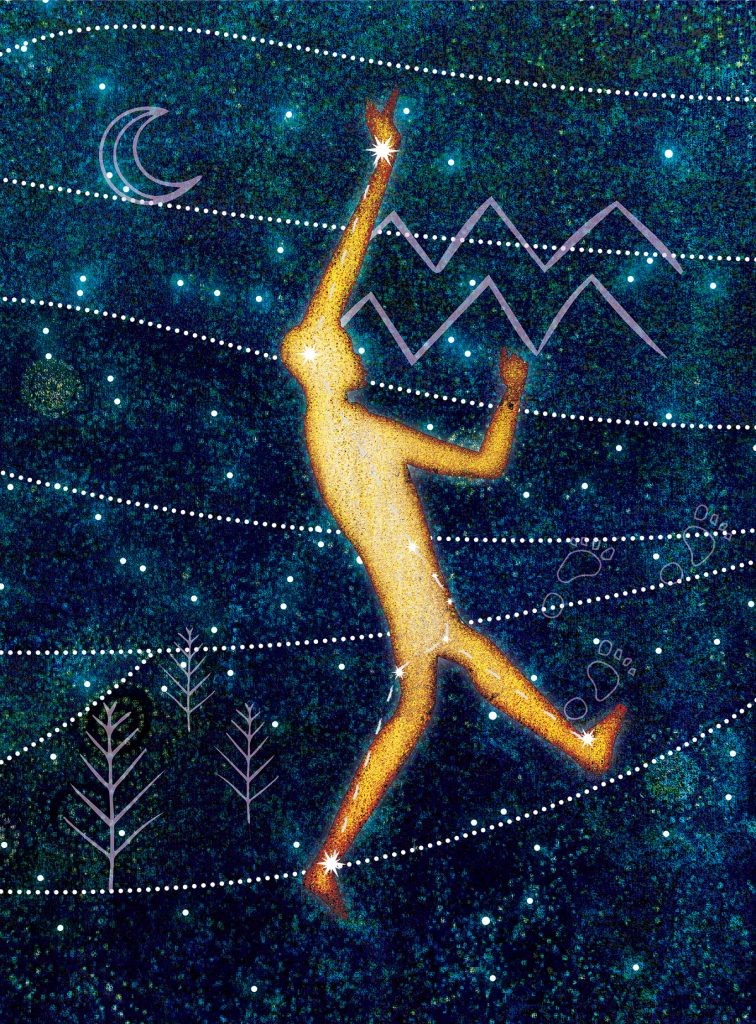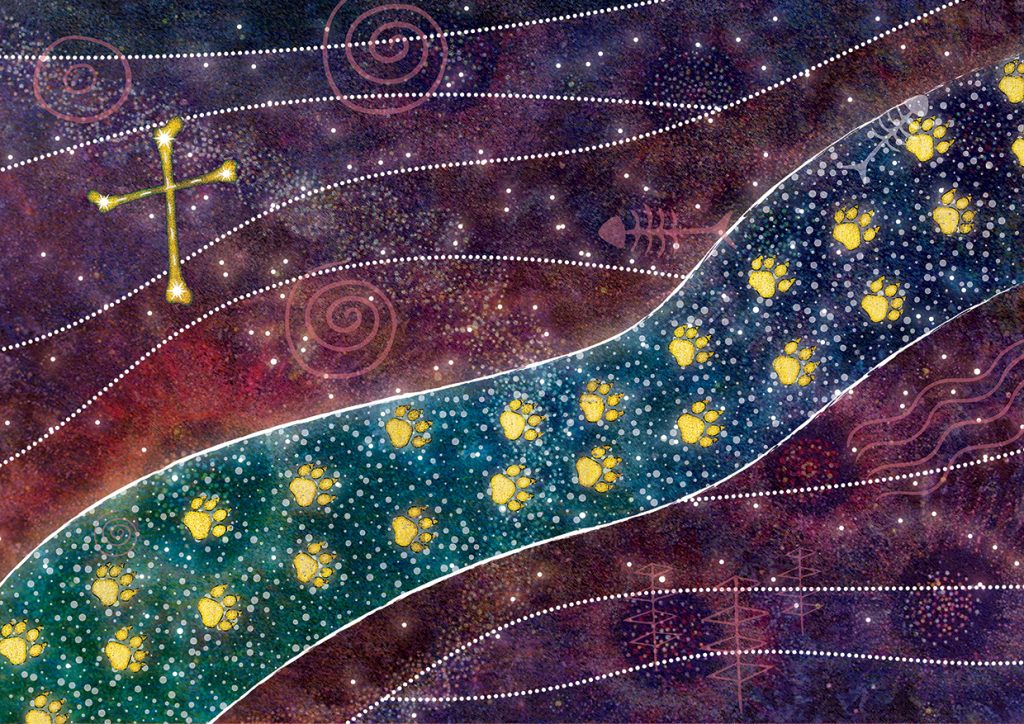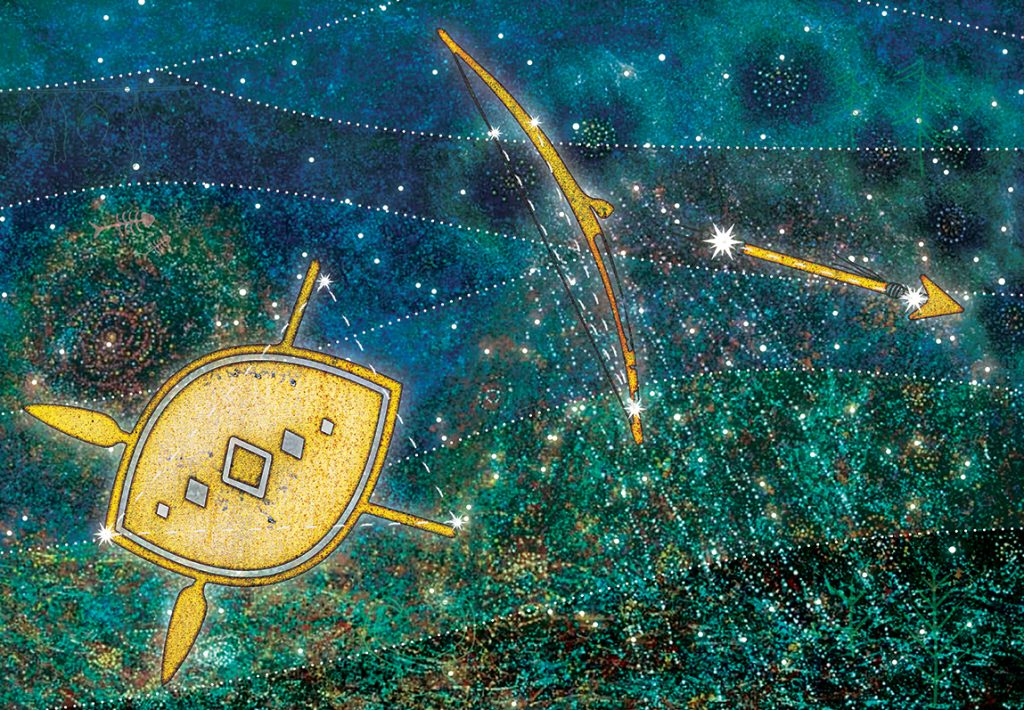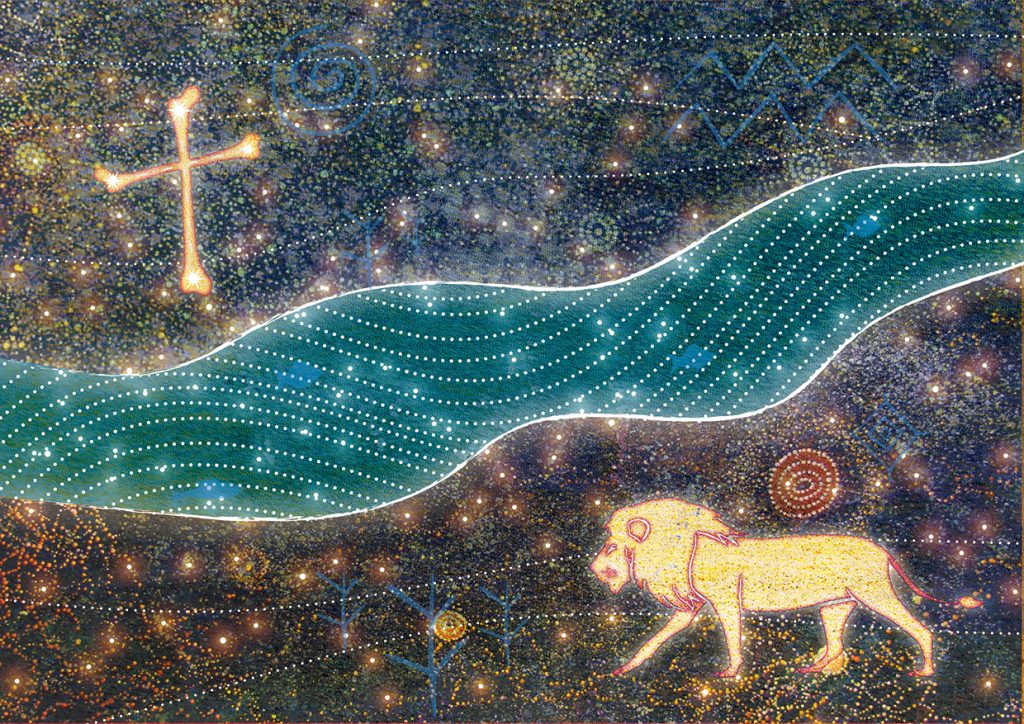Demystifying the Cosmos:
Beneath an African Sky
There were no stars in the sky when the night began. Alliance Française de Lusaka has evolved into the pulse of culture in Lusaka, hosting culturally innovative events that spark conversation and encourage people to look within. Still, Night of Stars was the first of its kind – encouraging guests to look up.
Night of Stars was dedicated to learning about astronomy and the connection between stars, constellations and Zambian cultural heritage. The dynamic crowd grew steadily as guests trickled in. The event was hosted and presented by Dr Mupanga Mwanakatwe and Mulenga Kapwepwe, joined by Samba Yonga, who graciously added dimension to the evening by sharing proper Chokwe pronunciations. With an illustrious career in telecommunications engineering and a keen mind for cosmology, Dr Mwanakatwe was armed with the wit, scientific appreciation and beautiful photography required to make us all fall in love with the night sky. Mulenga Kapwepwe is a culture and heritage savant, and any discussion with her instantly develops a new depth and understanding of self, society and purpose. There was a familiar expectation in the air.
When we gaze up at the night sky, we can’t help but feel a sense of childlike, hopeful wonder. While astronomy tends to take on a Western narrative, African cultures have their own profound connection to the stars. Stars are not just distant specks of light in the African night sky but the guiding lights of mythology, culture, and spirituality. Indigenous astronomical knowledge is recorded among many African tribes like the Dogon people of Mali, who have rich astronomical knowledge and are said to have made ancient observations of the planetary orbits of Saturn, Mars, Venus and Jupiter with her four major moons. The traditional astronomical knowledge of the San and Nguni people of Southern Africa is recorded to have guided their agriculture irrigation systems and inspired their religious practices. In Zambia, we have several national heritage conservation sites like the Mwela Rock Art Site in Kasama, where the brilliant understanding of meteors, comets, the sun, moon and stars is ethnographically depicted. In recent years, scientists have studied indigenous star knowledge with the help of modern technology, such as telescopes and satellites. Through these studies, scientists have confirmed many indigenous observations and astronomical beliefs.

In many African societies, navigating life with the guidance of stars has birthed a rich reservoir of practical knowledge useful for timekeeping, agriculture, geography, record keeping and history. The unique discoveries happen where traditional star knowledge and the science of astronomy intersect. From the Southern Hemisphere, one has an advantageous view of some of the universe’s most magnificent constellations. As skilled astronomers, the Chokwe people of Zambia gave the stars deep, rhythmic names with societal and historical significance.
As we explore culture and astronomy from the Chokwe perspective, we must state that we see the skies as we are. Our place on the planet determines our seasons, which affects what heavenly bodies we can observe. Perceptions of star patterns are influenced by the latitude of the observer, and from around 10 degrees south, the Chokwe had the geographical placement to observe and intertwine their star knowledge with their practices and identity.
For the Chokwe, stars are far more than celestial objects; they tell the story of their people, weaving an intricate tale that forms the fabric of their identity. To the Chokwe, the life of a star is like the story of man, starting with birth, coloured by obstacles and triumph, before ending with the honour of death. The night sky has served as a source of wisdom, a symbol of royalty, and a connection to their revered ancestors.
To learn Chokwe astronomy, we must begin with Tangwa, the sun; Ngonde, the moon’s phases; Litota, the stars; and Ntongonoshi, the universe in relation to the stars.

Royalty is a central part of Chokwe culture and is reflected in the sky where we see Ndumba, the lion that walks among the Tulamba – the ancestors, who guide his invisible stride in the Milky Way, leaving paw prints of litotain his path. The Chokwe people refer to the Milky Way as the Mulawiji or the Resting River, and it is used primarily as a star calendar and a compass. This shows an intimate knowledge of the skies as the orientation of the Milky Way changes considerably over the course of the year. Chokwe diviners call the Milky Way the Mulalankungu, which means the King’s Road. Nkungu is the name of the great, ancient Chokwe king, and the term refers to him. The Milky Way is a significant part of divination stories, and the diviner’s basket, or Ngombo, has objects that represent the stars that the diviner uses as symbols for interpretation.

We are also introduced to Tutumwe Twa Mwanangana, which means ‘Child of Wisdom’ or ‘Sending a Message to the Lord of the Land’. This constellation is depicted as four stars displaying a running, sweating messenger sent to announce the arrival of Mwenga, the new wife represented by the morning star, Venus. We see him spanning across four stars encapsulated in the three constellations of Bootes, Coronae Borealis and Herculis. The four stars, Alphecca, his head; Coronae Borealis accentuating the curve of his powerful hips as he runs; Herculis is his leg extended behind him and in his outstretched hand, Arcturus, the bright message of wisdom.
The beauty of Chokwe cosmology is endless, with serendipitous parallels to Western astronomy. For example, the hunter seen in Orion’s Belt is also seen as a hunter by the Chokwe, and they call it Tujita Jita, symbolically interpreted as ‘go to fight and always win’. Interestingly, for the Chokwe, the hunter is much closer to his dog in the constellation than in Greek and Egyptian mythology, where the dogs are in separate Canis Minor and Major constellations. Tujilika spans across three modern constellations of Triangulum Australe, Circinus and Centaurus. The symbolic meaning of Tujikila to the Chokwe people is ‘the children are protecting you.’

The Nkungu – The Southern Cross represents the ancestors’ bones shown by the four brightest stars connected in a cross, and this constellation guides the Mukanda, a circumcision initiation ceremony practised by the Chokwe.
The Seven Sisters, or The Pleiades, are Van Ava Nkungulwila, a lion’s claws. Nkungulwila refers to the Nkungu clan and its people, and just as they are together on earth, they are together in the heavens, forming a relationship between heaven, earth, life, and death. The Chokwe see the heavens as their ancestors’ home; in their cosmology, when people die, they are reborn in the lion’s claws – The Seven Sisters. Considering this belief, it is fascinating to note that astronomers have recognised that this constellation is a star factory where new stars are created as the interstellar gas cloud contracts under the force of gravity. There are reddish stars within the constellation that astronomers recognise as dying stars in a supernova, which the Chokwe recognise as the Nalindele; a star whose season is over and is waning; this story is told in relation to an old wife.

Ancient Chokwe star lore, steeped in symbolism and cultural significance, aligns intriguingly with Western scientific discoveries. It’s a reminder that despite diverse perspectives, our shared celestial heritage connects us all.
Modern Zambian society is embracing its traditional star knowledge in exciting ways. Young Zambians blend age-old wisdom with contemporary science and technology, forging a path towards the stars. A brief look can be taken at the enduring legacy of the Zambia Space Program of Edward Nkoloso, who coined the term Afronauts, which has come to embody a time when Zambians were bold and brave about exploring the wondrous mysteries of the universe.

The stars have a unique way of uniting us all, transcending borders, cultures, and time. Our fascination with the night sky is universal, but it’s crucial to stay curious and remember that the cosmos is vast and diverse, just like the cultures it inspires. Whether you’re gazing at the stars from the Chokwe heartlands of Northwestern Zambia or the bustling streets of Lusaka, we’re all part of a timeless story that stretches beyond the horizon of our understanding. The stars above are the same stars that have guided us since time immemorial, reminding us of our shared journey through the great expanse of the universe.
Keep your eyes up.



